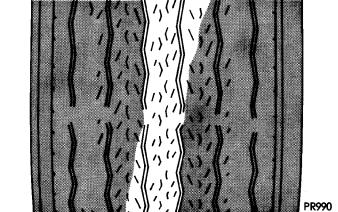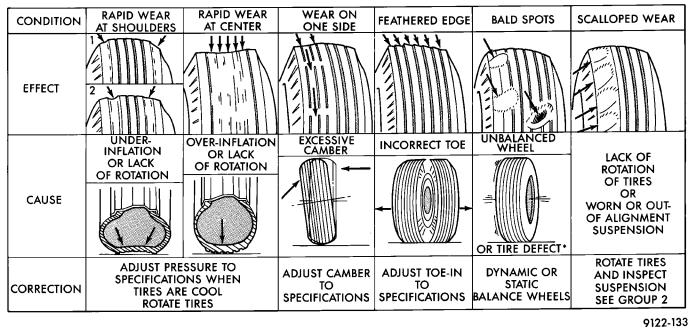
- •TIRE SERVICE PROCEDURES
- •GENERAL INFORMATION
- •TIRE CHAINS
- •CLEANING OF TIRES
- •PRESSURE GAUGES
- •TIRE INFLATION PRESSURES
- •REPLACEMENT TIRES
- •ROTATION
- •DIRECTIONAL TREAD PATTERN TIRES
- •NONDIRECTIONAL TIRES
- •TREAD WEAR INDICATORS
- •REPAIRING LEAKS
- •TIRE NOISE OR VIBRATION
- •TIRE WEAR PATTERNS
- •LEAD CORRECTION CHART
- •WHEEL SERVICE PROCEDURES
- •GENERAL INFORMATION
- •WHEEL INSTALLATION
- •WHEEL REPLACEMENT
- •TIRE AND WHEEL BALANCE
- •TIRE AND WHEEL RUN OUT
- •METHOD 1 (RELOCATE WHEEL ON HUB)
- •METHOD 2 (RELOCATE TIRE ON WHEEL)
- •SPECIFICATIONS
- •TIRE SPECIFICATIONS
- •TIGHTENING REFERENCE

Ä |
|
WHEELSÐTIRES 22 - 3 |
|
ponents. Under extremes of suspension and steering travel tire damage may occur.
WARNING: FAILURE TO EQUIP THE VEHICLE WITH TIRES HAVING ADEQUATE SPEED RATING CAN CAUSE SUDDEN TIRE FAILURE.
ROTATION
DIRECTIONAL TREAD PATTERN TIRES
Some vehicles are fitted with special highperformance tires having a directional tread pattern designed to improve traction on wet pavement.
To obtain the full benefits of this design, the tires must be installed so that they rotate in the correct direction. This is indicated by arrows on the tire sidewalls.
When wheels and tires are being installed, extra care is needed to ensure that this direction of rotation is maintained.
Refer to Owner's Manual for rotation schedule.
NONDIRECTIONAL TIRES
Tires on the front and rear axles of vehicles operate at different loads and perform different steering, driving, and braking functions. For these reasons, they wear at unequal rates, and tend to develop irregular wear patterns. These effects can be reduced by timely rotation of tires. Rotation will increase tread life, help to maintain mud, snow, and wet traction levels, and contribute to a smooth, quiet ride.
The suggested rotation method is the forward-cross tire rotation method. This method takes advantage of current tire industry practice which now allows cross rotation of radial-ply tires. Refer to the owner's manual (usually found in the glove box) for additional information. Other rotation methods may be used, but may not have all the benefits of the recommended method.
Always check air pressure and wheel nut tightness after rotation. Do NOT use oil or grease on studs or nuts.
Refer to Owner's Manual for rotation schedule.
TREAD WEAR INDICATORS
Tread wear indicators (Fig. 3) are molded into the bottom of the tread grooves. When tread is 1.6 mm (1/16 in.), the tread wear indicators will appear as a 13 mm (1/2 in.) band.
Tire replacement is necessary when indicators appear in two or more grooves, or if localized balding occurs.
Fig. 3 Tread Wear Indicators
REPAIRING LEAKS
For proper repairing, a radial tire must be removed from the wheel. Repairs should only be made if the defect or puncture is in the tread area otherwise the tire should be replaced.
Deflate tire completely before dismounting tire from the wheel. Use lubrication such as a mild soap solution when dismounting or mounting tire. Use tools free of burrs or sharp edges which could damage the tire or wheel rim.
Before mounting tire on wheel, make sure all rust scale is removed from the rim and repaint if necessary.
Install wheels on vehicle, progressively tightening wheel nuts to 129 NIm (95 ft. lbs.) torque (See Wheels).
TIRE NOISE OR VIBRATION
Radial-ply tires are sensitive to force impulses caused by improper mounting, wheel irregularities, or imbalance.
To determine if the tires are causing the noise or vibration, drive the vehicle over a smooth portion of highway at different speeds and note the effect of acceleration and deceleration on noise level. Differential and exhaust noise will change in intensity as speed varies, while tire noise will usually remain constant.
TIRE WEAR PATTERNS
Under inflation results in faster wear on shoulders of tire.
Over inflation causes faster wear at center of tread. Excessive camber causes the tire to run at an angle to the road. One side of tread is worn more than the
other.
Excessive toe-in or toe-out causes wear on the tread edges of the tire, from dragging of tire. There is a feathered effect across the tread (Fig. 4).

22 - 4 WHEELSÐTIRES |
|
Ä |
|
Fig. 4 Tire Wear Patterns

Ä |
|
WHEELSÐTIRES 22 - 5 |
|
